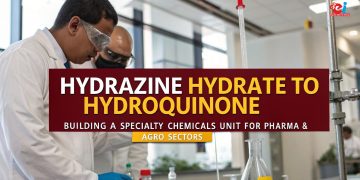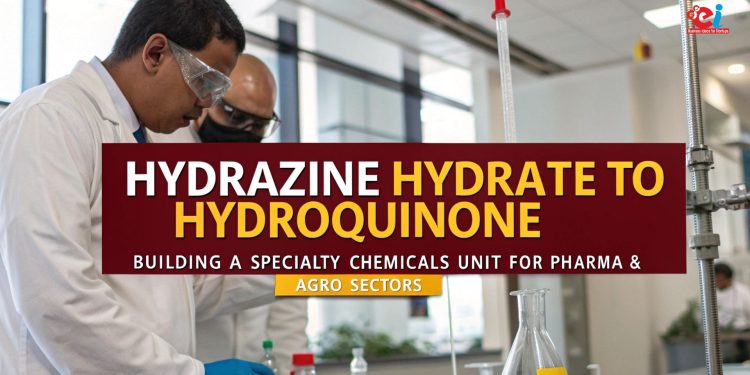A Strategic Entry into High-Demand Specialty Chemicals
With the recent demand rise in specialty chemicals industry across the globe, the pharmaceutical and agrochemical sectors are particularly paying attention because product effectiveness hinges on accuracy, cleanliness, and adherence to regulations. Within this scope, two compounds show great significance—Hydrazine Hydrate and Hydroquinone—due to their industrial importance, worldwide applicability, and ease of production.
Both Hydrazine Hydrate and Hydroquinone are crucial in the production of other chemicals, which is why they are considered as intermediates. Hydrazine Hydrate is an intermediate used in manufacturing several drugs, herbicides, and polymer foaming agents. Hydroquinone is also an important intermediate utilized in the production of APIs, in photo developing, as an antioxidant, and in makeup and pesticide formulations. Both chemicals have strict manufacturing guidelines and regulations that control their production, as well as their use because they are the essential components for more complex and valuable artificial products.
Plant construction with an emphasis on the conversion process from Hydrazine Hydrate to Hydroquinone can be extremely rewarding in terms of profit as well as strategically. For entrepreneurs and MSME manufacturers looking to establish a chemically intensive industrial unit, this approach creates value. In this article, we will explore the process, regulations, and the technology needed to establish an industrial unit of this kind while focusing on operations and best practices. The tone of this article will be professional while also tailored to attract visibility on search engines and focus on relevance for startups.
Related: How to Launch a Specialty Chemical Manufacturing Unit in India: Opportunities and Challenges
Tracing the Chemical Connection: Hydrazine Hydrate and Hydroquinone Production
As a compound with high-energy reactions, Hydrazine Hydrate (N₂H₄·H₂O) is useful for reduction, deoxygenation, or polymer modification. It also serves as an intermediate reactant in multiple organic synthesis chains, including the production of hydroquinone.
Hydroquinone (C₆H₄(OH)₂), or benzene-1,4-diol, has several industrial production pathways, but one of the most efficient pathways involves the reduction of its precursor—p-benzoquinone—which is produced via the controlled oxidation and reduction of aromatic precursors with Hydrazine Hydrate.
These pathways create a notable value chain. Vertical integration is used to improve the economic and material efficiency of the processes. Manufacturers control these upstream and downstream processes to reduce expenses, improve material-grade checks, and supply high-purity specialty chemicals to formulation plants and API manufacturers or directly to export markets.
Reasoning Behind the Chemical Vertical’s Parameter Value
These chemicals do not qualify as commodity chemicals, because they are categorized as specialty and fine chemicals. These two categories require unique product consistency, absolute application compatibility, and strict non-negotiable purity. Therefore, these categories provide a competitive advantage when precise tailored specifications, compliance benchmark multi-grade supplies, or configurable multi-tiered supply chains are provided.
Some important advantages of this segment are:
- Multi-sector applicability – In pharmaceuticals: hydroxyurea (API), skin lightening agents. In agrochemicals: herbicide intermediates. In polymers and dyes.
- Export potential – Key hydroquinone and hydrazine intermediates have significant export opportunities in the European Union, United States, and Asia Pacific Regions.
- Recurring demand – There are predictable consumption cycles in downstream industries, which sustains business.
- Moderate entry barriers – While not fully commoditized, there is moderate capital required for MSME’s with specialized knowledge in the field.
This vertical offers a pathway to enduring and industrial relevance for entrepreneurs seeking sustained process-based value creation.
Related: How Chemical Manufacturing is Adapting to Sustainable Chemical Manufacturing Practices
Overview of the Manufacturing Process: Step-By-Step
Setting up a specialty chemicals plant requires several technical steps, especially for sensitive or reactive materials like Hydrazine Hydrate. Below is an abridged process chain for converting Hydrazine Hydrate to Hydroquinone (with intermediate steps, often via benzoquinone).
1. Acquisition and Management of Hydrazine Hydrate
Hydrazine Hydrate can be obtained as a raw material or synthesized from ammonia derivatives and hydrogen peroxide in the presence of ketone catalysts. Due to toxicity and volatility, this chemical requires closed-loop, explosion-proof systems with dedicated vents for handling.
2. Synthesis of p-Benzoquinone (Intermediate Stage)
Starting with an aromatic precursor such as aniline or phenol, these compounds can be transformed into benzoquinone via their oxidation using nitric acid or oxygen as oxidizing agents, usually in the presence of a catalyst such as manganese salts. This step is crucial because it has strict limits on reaction time, temperature, and pH.
3. Reduction to Hydroquinone
Add hydrazine hydrate or hydrogen gas with palladium catalyst to p-benzoquinone to reduce it to hydroquinone at certain temperatures and with specific amounts of stirring. Optimal conditions for the reaction guarantee by-products loss and compound’s yield and purity maximization.
4. Crystallization and Purification
The modified hydroquinone may be further purified by crystallization using water, ethanol, or acetone. Depending on customer requirements, it may also undergo recrystallization, micronization, and drying.
5. Packaging and Quality Control
Finished hydroquinone products are packed in moisture-proof, sealed containers under inert conditions. Each batch goes through HPLC along with melting point and impurity profiling prior to release.
Required Infrastructure and Raw Materials
Raw Materials Required
- Hydrazine Hydrate (55–80%)
- Phenol or Aniline (for benzoquinone synthesis)
- Catalysts like manganese oxide, copper salts
- Oxidizing agents (e.g., HNO₃, H₂O₂)
- Solvents: Acetone, ethanol, distilled water
- Acid/base control agents
Infrastructure Needs
- Stainless steel or glass-lined reactors (for corrosive handling)
- Distillation columns and cooling jackets
- Dust-free drying chambers
- Fume hoods, ETP (Effluent Treatment Plant), and scrubbers
- Power backup, safety alarms, and fireproof storage
Your plant must have the following to facilitate carefully planned layouts: Separate dangerous reaction processes from packaging and storage to reduce contamination risks.
For more information check our Project Reports
Quality Standards, Licensing and Other Regulations
Considering the pharmaceutical and agro applications, both hydrazine hydrate and hydroquinone pose stringent danger and safety concerns.
Following are guidelines that must be observed:
- MSME Udyam Registration
- BIS or IP-grade Hydroquinone (if used in pharma)
- Factory License and Site Approvals Under the Factories Act
- Pollution Control Board NOC and Hazardous Waste Handling Certification
- Drug License or FSSAI for cosmetic/pharma supplying intermediates
- REACH or GHS labels for international shipments
By implementing ISO 9001, ISO 14001, and cGMP standards, you enhance your credibility and appeal to multinational companies, export houses, and government entities.
Client Types and Earnings Possibilities
This segment serves a combination of industrial clients and those in formulation. They consist of:
- API companies needing Hydroquinone as an intermediate or starting material.
- Cosmetic manufacturers producing melanin inhibitors as well as skincare formulations.
- Agrochemical companies utilizing it as a building block in herbicides and fungicides.
- Rubber and polymer processing industries using Hydroquinone as a stabilizer.
- For high purity applications, analytical labs and chemical resale entities.
Sales in B2B markets are mostly contractual and clients demand strict adherence to Cookbook, MSDS, COA and other documentation requirements along with reliable, punctual supply.
Sales can be boosted by hiring a chemical salesperson, providing informative sites LinkedIn, Chemxpert, IndiaMART, and ExportHub and customization, private labeling, and comprehensive export guide add invaluable competitive spices.
Production Obstacles and Solutions
Working with reactive chemicals makes safety a concern. With sound planning, the right approach to safety, and effective procedures, obstacles can be minimized.
1. Addressing Safety Risk Issues
All operational processes need to be contained, thus enveloping all workflow units. Each unit must use a double-sealed reactor system with emergency shut off valves.
2. Meeting Environmental Guidelines
Liquid and gaseous byproducts require ETP and air scrubbers for treatment. It is advisable to work with a licensed hazardous material waste disposal firm.
3. Consistency in Purity
Changes in input purity or reaction conditions will inevitably impact Hydroquinone’s final specifications. Implement batch HPLC calibration as your primary method and ensure quality control teams are well trained.
4. Skilled Manpower Shortage
Quaternary units of specialty chemicals require experienced personnel. Partner with ITIs and other colleges or agencies offering chemical engineering and industrial training for recruitment.
How NPCS Can Support Entrepreneurs Entering Specialty Chemicals
Niir Project Consultancy Services (NPCS) offers vital support to entrepreneurs looking to enter complex industrial segments like specialty chemicals. Their Market Survey cum Techno-Economic Feasibility Reports are based on real-time industry data and include:
- Detailed manufacturing processes and flowcharts
- Plant layout, raw material sources, and equipment selection
- Industry-wise demand analysis, risk factors, and compliance checklists
- Financials, ROI planning, and scalability strategies
Whether you’re a startup entering the space or an established unit looking to forward-integrate, NPCS equips you with the knowledge and tools to succeed confidently.
Conclusion: Your Pathway into High-Value Industrial Chemistry
The conversion of Hydrazine Hydrate to Hydroquinone is more than just a chemical reaction—it’s a well-defined industrial opportunity. It offers Indian entrepreneurs access to a lucrative value chain with applications across pharma, agro, polymers, and cosmetics. By combining technical discipline with regulatory foresight, this business can scale efficiently and even support export growth.
With demand rising, compliance improving, and support systems like NPCS in place, there has never been a better time to enter India’s specialty chemical sector with a unit that is both future-ready and commercially viable.


















